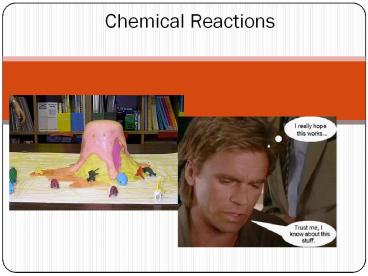Chemical Reactions PowerPoint PPT Presentation
1 / 20
Title: Chemical Reactions
1
Chemical Reactions
2
Types of Reactions
- There are five types of chemical reactions we
will talk about - You need to be able to identify the type of
reaction and predict the product(s)
3
Steps to Writing Reactions
- Some steps for doing reactions
- Dont forget about the diatomic elements! (Br, I,
N, Cl, H, O, F) - For example, Oxygen is O2 as an element.
- In a compound, it cant be a diatomic element
because its not an element anymore, its a
compound!
4
1. Synthesis reactions
- Synthesis reactions occur when two substances
(generally elements) combine and form a compound.
(Sometimes these are called combination or
addition reactions.) - Basically
- Example
- Example
5
Synthesis Reactions
- Here is another example of a synthesis reaction
6
Practice
- Predict the products. Write and balance the
following synthesis reaction equations. - Sodium metal reacts with chlorine gas
- Na(s) Cl2(g) ?
- Solid Magnesium reacts with fluorine gas
- Mg(s) F2(g) ?
- Aluminum metal reacts with fluorine gas
- Al(s) F2(g) ?
7
2. Decomposition Reactions
- Decomposition reactions occur when a compound
breaks up into the elements or in a few to
simpler compounds - In general
- Example
- Example
8
Decomposition Reactions
- Another view of a decomposition reaction
9
Decomposition Exceptions
- Carbonates and chlorates are special case
decomposition reactions that do not go to the
elements. - Carbonates (CO32-) decompose to carbon dioxide
and a metal oxide - Example CaCO3 ? CO2 CaO
- Chlorates (ClO3-) decompose to oxygen gas and a
metal chloride - Example 2 Al(ClO3)3 ? 2 AlCl3 9 O2
- There are other special cases, but we will not
explore those in Chemistry I
10
Practice
- Predict the products. Then, write and balance
the following decomposition reaction equations - Solid Lead (IV) oxide decomposes
PbO2(s) ? - Aluminum nitride decomposes
- AlN(s) ?
11
3. Single Replacement Reactions
- Single Replacement Reactions occur when one
element replaces another in a compound. - A metal can replace a metal () OR a nonmetal
can replace a nonmetal (-). - When H2O splits into ions, it splits into
- H and OH- (not H and O-2 !!)
12
Single Replacement Reactions
- Another view
13
Single Replacement Reactions
- Write and balance the following single
replacement reaction equation - Zinc metal reacts with aqueous hydrochloric acid
- Zn(s) HCl(aq) ? ZnCl2
H2(g) - Note Zinc replaces the hydrogen ion in the
reaction
2
14
Single Replacement Reactions
- Sodium chloride solid reacts with fluorine gas
- NaCl(s) F2(g) ? NaF(s)
Cl2(g) - Note that fluorine replaces chlorine in the
compound - Aluminum metal reacts with aqueous copper (II)
nitrate - Al(s) Cu(NO3)2(aq)?
2
2
15
4. Double Replacement Reactions
- Double Replacement Reactions occur when a metal
replaces a metal in a compound and a nonmetal
replaces a nonmetal in a compound
16
Double Replacement Reactions
- Think about it like foiling in algebra, first
and last ions go together inside ions go
together - Example
- AgNO3(aq) NaCl(s) ? AgCl(s) NaNO3(aq)
- Another example
- K2SO4(aq) Ba(NO3)2(aq) ? KNO3(aq) BaSO4(s)
2
17
Practice
- Predict the products. Balance the equation
- HCl(aq) AgNO3(aq) ?
- CaCl2(aq) Na3PO4(aq) ?
- Pb(NO3)2(aq) BaCl2(aq) ?
- FeCl3(aq) NaOH(aq) ?
- H2SO4(aq) NaOH(aq) ?
- KOH(aq) CuSO4(aq) ?
18
5. Combustion Reactions
- Combustion reactions occur when a hydrocarbon
reacts with oxygen gas. - This is also called burning!!! In order to burn
something you need the 3 things in the fire
triangle1) A Fuel (hydrocarbon)2) Oxygen to
burn it with3) Something to ignite the reaction
(spark)
19
Combustion Reactions
- In general CxHy O2 ? CO2 H2O
- Products in combustion are ALWAYS carbon dioxide
and water. (although incomplete burning does
cause some by-products like carbon monoxide) - Combustion is used to heat homes and run
automobiles (octane, as in gasoline, is C8H18)
20
Combustion
- Example
- C5H12 O2 ? CO2 H2O
- Write the products and balance the following
combustion reaction - C10H22 O2 ?
5
6
8

